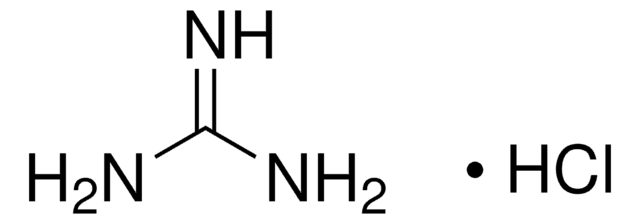G3272
Guanidine hydrochloride
for molecular biology, ≥99%
Recommended Products
biological source
synthetic (organic)
grade
for molecular biology
Assay
≥99%
form
crystalline powder
technique(s)
RNA extraction: suitable
impurities
≤0.3% water (Karl Fischer)
color
white
pH
(25 °C, 4.6 - 6/573 g/L)
mp
180-185 °C (lit.)
solubility
H2O: 6 M, clear, colorless
density
1.3 g/cm3 (lit.)
cation traces
Pb: ≤5 ppm
UV absorption
λ: 260 nm Amax: ≤0.10
λ: 290 nm Amax: ≤0.05
foreign activity
DNase, RNase, none detected
SMILES string
Cl[H].NC(N)=N
InChI
1S/CH5N3.ClH/c2-1(3)4;/h(H5,2,3,4);1H
InChI key
PJJJBBJSCAKJQF-UHFFFAOYSA-N
Gene Information
human ... KCNA1(3736) , KCNA10(3744) , KCNA2(3737) , KCNA3(3738) , KCNA4(3739) , KCNA5(3741) , KCNA6(3742) , KCNA7(3743) , KCNB1(3745) , KCNB2(9312) , KCNC1(3746) , KCNC2(3747) , KCNC3(3748) , KCNC4(3749) , KCND1(3750) , KCND2(3751) , KCND3(3752) , KCNF1(3754) , KCNG1(3755) , KCNG2(26251) , KCNG3(170850) , KCNG4(93107) , KCNH1(3756) , KCNH2(3757) , KCNH3(23416) , KCNH4(23415) , KCNH5(27133) , KCNH6(81033) , KCNH7(90134) , KCNH8(131096) , KCNQ1(3784) , KCNQ2(3785) , KCNQ3(3786) , KCNQ4(9132) , KCNQ5(56479) , KCNS1(3787) , KCNS2(3788) , KCNS3(3790) , KCNV1(27012) , KCNV2(169522)
Looking for similar products? Visit Product Comparison Guide
Related Categories
Application
- as a component of the extraction buffer for the extraction of proteoglycans
- in extraction during protein fractionation of ATDC5 cell lines
- as a chemical additive to study its effective absorbance spectra in structural analysis
- to incubate the device chip to release prostate-specific antigen and for regeneration of aptamer
- as a component of the 2,4-dinitrophenylhydrazine (DNPH) solution for detecting protein carbonyls by protein carbonylation study
- in RNA isolation to dissociate nucleoproteins and inhibit RNase
Biochem/physiol Actions
Caution
Preparation Note
The maximum solubility of guanidine hydrochloride in water at room temperature is approximately 6M.
Signal Word
Warning
Hazard Statements
Precautionary Statements
Hazard Classifications
Acute Tox. 4 Inhalation - Acute Tox. 4 Oral - Eye Irrit. 2 - Skin Irrit. 2
Storage Class Code
11 - Combustible Solids
WGK
WGK 1
Flash Point(F)
Not applicable
Flash Point(C)
Not applicable
Personal Protective Equipment
Certificates of Analysis (COA)
Search for Certificates of Analysis (COA) by entering the products Lot/Batch Number. Lot and Batch Numbers can be found on a product’s label following the words ‘Lot’ or ‘Batch’.
Already Own This Product?
Documents related to the products that you have purchased in the past have been gathered in the Document Library for your convenience.
Difficulty Finding Your Product Or Lot/Batch Number?
How to Find the Product Number
Product numbers are combined with Pack Sizes/Quantity when displayed on the website (example: T1503-25G). Please make sure you enter ONLY the product number in the Product Number field (example: T1503).
Example:
Additional examples:
705578-5MG-PW
PL860-CGA/SHF-1EA
MMYOMAG-74K-13
1000309185
enter as 1.000309185)
Having trouble? Feel free to contact Technical Service for assistance.
How to Find a Lot/Batch Number for COA
Lot and Batch Numbers can be found on a product's label following the words 'Lot' or 'Batch'.
Aldrich Products
For a lot number such as TO09019TO, enter it as 09019TO (without the first two letters 'TO').
For a lot number with a filling-code such as 05427ES-021, enter it as 05427ES (without the filling-code '-021').
For a lot number with a filling-code such as STBB0728K9, enter it as STBB0728 without the filling-code 'K9'.
Not Finding What You Are Looking For?
In some cases, a COA may not be available online. If your search was unable to find the COA you can request one.
Protocols
TRI Reagent is a single-step RNA isolation reagent that allows simultaneous isolation of DNA, RNA and protein. This protocol outlines sample prep as well as extraction of the various samples and troubleshooting.
Our team of scientists has experience in all areas of research including Life Science, Material Science, Chemical Synthesis, Chromatography, Analytical and many others.
Contact Technical Service



